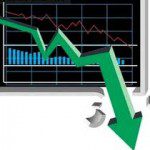Right now there’s nothing to be bearish about. I say that with conviction, because  my “Bear Market Checklist” is a perfect 0-for-9. Heck, not a single indicator on the list is even close to flashing a warning sign. We’ve got nothing but big whiffers! Take a look. Pop a pill and relax. There’s no immediate danger threatening stocks.
my “Bear Market Checklist” is a perfect 0-for-9. Heck, not a single indicator on the list is even close to flashing a warning sign. We’ve got nothing but big whiffers! Take a look. Pop a pill and relax. There’s no immediate danger threatening stocks.
So writes Lou Basenese (www.wallstreetdaily.com) in edited excerpts from his original article* as posted on his site under the title Time to Sell Stocks? Consult This Bear Market Checklist First.
(NOTE: This post is presented by Lorimer Wilson, editor of www.munKNEE.com and the free Intelligence Report newsletter (see sample here). The article may have been edited ([ ]), abridged (…) and/or reformatted (some sub-titles and bold/italics emphases) for the sake of clarity and brevity to ensure a fast and easy read. This paragraph must be included in any article re-posting to avoid copyright infringement.)
Submit your own articles & article suggestions here for posting consideration. “Follow the munKNEE” daily posts via Twitter or Facebook.
Basenese goes on to say in further edited excerpts:
~Bear Market Warning Sign #1: A Tightening Fed
When the Fed…starts tightening monetary policy, it’s time to keep an eye on the exits…because they have a tendency to overdo it, thereby creating a much more challenging environment for businesses. As Richard Bernstein notes, “Historically, bull markets didn’t end when the Fed started to tighten. Rather, they ended after the Fed tightened too much.” We’re in the clear now, though, since Ben Bernanke isn’t even contemplating an end to the quantitative easing efforts.
If you want something specific to track, look at the yield curve. That is, the difference in short-term and long-term government bond yields. When it inverts (i.e. – short-term yields rise above long-term yields), it’s a surefire indicator that the Fed has tightened too much. As you can see below the current yield curve is nowhere near inverted.

Stock prices ultimately follow earnings…so when corporate profitability starts taking a hit, it’s only a matter of time before stock prices head south, too. [In that regard, however, we currently] have got nothing to worry about. In the first quarter, S&P 500 companies reported a 3.2% increase in earnings and analysts expect them to keep growing over the next three quarters, by 1.6%, 7.9% and 14.2%, respectively.
~Bear Market Warning Sign #3: A Recession is Coming! A Recession is Coming
Economic activity tends to slow down long before corporate profits take a hit so we need to be on the lookout for reliable signs of a looming recession. I say “reliable” because, at any given time, there are always a handful of analysts warning that a recession is coming.
Ignore the Chicken Littles – and their opinions. Instead, focus on the hard data, including the two most reliable recession indicators I shared with you in late March – Piger’s “Recession Probability Index” and the 2/10 Spread. (For the record, they aren’t flashing any warning signs.)
Although the economy isn’t firing on all cylinders, it’s growing nonetheless. The latest estimates call for GDP growth of about 2% this year.
~Bear Market Warning Sign #4: A Spike in CDS Prices
With all the funny money being pumped into the market by the Federal Reserve, another banking crisis is the biggest threat to the stock market…[yet when we] consult the latest prices for credit default swaps (CDS) for banks and brokers (if banks are truly about to pull the stock market into the abyss, CDS prices should be rising rapidly) [it is evident that,] right now, we have nothing to fear but fear itself.
As Bespoke Investment Group says, “Our Bank and Broker CDS Index is now at its lowest level since April 15, 2010. Over the last week alone, financial-sector default risk is down 8.5%, and it’s down 50% over the last year.” [See chart below.]

Stay tuned for tomorrow’s column, where I plan to share the remaining five indicators on our “Bear Market Checklist.” In the meantime, pop a pill and relax. There’s no immediate danger threatening stocks.
Ahead of the tape,

(Editor’s Note: The author’s views and conclusions in the above article are unaltered and no personal comments have been included to maintain the integrity of the original post. Furthermore, the views, conclusions and any recommendations offered in this article are not to be construed as an endorsement of such by the editor.)
*http://www.wallstreetdaily.com/2013/05/15/bear-market-indicators/ (© 2013 Wall Street Daily, LLC. All rights reserved.)
Related Articles for a Balanced View:
A. Optimistic Views of the Market
1. Latest Action Suggests Stock Market Beginning a New Long-term Bull Market – Here’s Why
There are several fundamental reasons to believe that this week’s stock market activity, where the S&P 500 has moved more than 4% above the 13-year trading range defined by the 2000 and 2007 highs, could mark the beginning of a long-term bull market and the end of the range-bound trading that has lasted for 13 years. Read More »
2. Sorry Bears – The Facts Show That the U.S. Recovery Is Legit – Here’s Why
Today, I’m dishing on the unbelievable rebound in residential real estate, pesky rumors about the dollar’s demise and a resurgent U.S. stock market. So let’s get to it. Read More »
3. Stocks Are NOT In Another Bubble – Here’s Why
U.S. stocks are off to one of their best starts in years. Most indices are up 10% year to date, prompting many investors to ask: “Are we in another bubble?” The answer is no, at least when it comes to equities. Here are three reasons why:
4. Research Says Stock Market Bull Should Continue Its Run Until…
The mainstream financial press would like us to believe that because the S&P 500 and Dow 30 are at or near their record highs that it must mean we’re nearing the end of the current bull market and, as such, now must be a terrible time to buy stocks. Let’s not jump to any conclusions, though. Instead, let’s do our own due diligence to find out. Hint: If you’ve been stuffing cash under the mattress since the last market crash, you might want to finally go deposit it in your brokerage account. Here’s why… Words: 420
5. These 4 Indicators Say “No Stock Market Correction Coming – Yet”
While I remain cautious on stocks and the risk trade, the technical picture shows that the uptrend to be intact and the bulls should still be given the benefit of the doubt for now. At this point, any call for a correction is at best conjecture [as evidenced by the following 4 indicators]. Words: 399; Charts: 4
The Swimsuit Issue Indicator says that U.S. equity markets perform better in years when an American appears on the cover of Sports Illustrated’s annual issue as opposed to years when a non-American appears on the cover. [What is the nationality of this year’s cover model? Can we expect returns above the norm or will we see a year of underperformance for the S&P 500 this year? Read on.] Words: 323 ; Table: 1
7. Bull Market in Stocks Isn’t About to End Anytime Soon! Here’s Why
As we all know, money printing always leads to inflation. It’s just a matter of figuring out which assets get inflated. This time around gold is not the only beneficiary, stocks are, too, and I’m convinced that the chart below holds the key to the end of the bull market. Words: 475; Charts: 1
8. QE Could Drive S&P 500 UP 25% in 2013 & UP Another 28% in 2014 – Here’s Why
Ever since the Dow broke the 14,000 mark and the S&P broke the 1,500 mark, even in the face of a shrinking GDP print, a lot of investors and commentators have been anxious. Some are proclaiming a rocket ride to the moon as bond money now rotates into stocks….[while] others are ringing the warning bell that this may be the beginning of the end, and a correction is likely coming. I find it a bit surprising, however, that no one is talking of the single largest driver for stocks in the past 4 years – massive monetary base expansion by the Fed. (This article does just that and concludes that the S&P 500 could well see a year end number of 1872 (+25%) and, realistically, another 28% increase in 2014 to 2387 which would represent a 60% increase from today’s level.) Words: 600; Charts: 3
9. 5 Reasons To Be Positive On Equities
For the month of January, U.S. stocks experienced the best month in more than two decades [and the Dow hit 14,009 on Feb. 1st for the first time since 2007]. Per the Stock Traders’ Almanac market indicator, the “January Barometer,” the performance of the S&P 500 Index in the first month of the year dictates where stock prices will head for the year. Let’s hope so…. [This article identifies f more solid reasons why equities should do well in 2013.] Words: 453
10. Start Investing In Equities – Your Future Self May Thank You. Here’s Why
As Winston Churchill once said: “A pessimist sees the difficulty in every opportunity; an optimist sees the opportunity in every difficulty” and in that vain I challenge all readers to fight off the negativity, see long-term opportunity in global equity markets and, most importantly, remain invested. Your future self may thank you. Words: 732; Charts: 6
11. Investors, Get Fully Invested! S&P 500 On Verge of Entering Euphoria Stage of Cyclical Bull Market
B. Pessimistic Views of the Market
1. Stock Markets Ripe for a MAJOR Selloff – Here’s Why
Despite bulls’ assertions otherwise, the stock markets are not cheap today. They are quite expensive and very overbought, ripe for a serious selloff. The S&P 500 stock index now has average valuations matching the ones seen in October 2007 when the last cyclical bull topped. Valuations should be around 12x or 13x now, 13 years into this 17-year secular bear. … Read More
2. Stock Market Will Crash Within 2 Months! Here’s Why
The euphoria phase of the bull market that I warned about months ago is now beginning its final parabolic phase. I’m guessing we still have another 1 to 1.5 months before this runaway move finally ends. Read More »
3. S&P 500′s PEG Ratio Suggests Overvaluation & Coming Correction
The S&P 500 index is trading at record high levels and optimism remains high with Barron’s professional money manager survey indicating a record 74% money managers being bullish on markets even at current levels. [When one] measures valuations with respect to expected growth, [however, the ensuing ratio, the PEG ratio,] suggests overvaluation at these levels. [Let me explain further.] Words: 254; Charts: 1 Read More »
4. Can S&P 500 Justify Current Level With Earnings Growth So Weak?
The S&P 500 is trading at near record high levels on the back of liquidity glut in the financial system. I mention the liquidity factor because all other fundamental factors do not support current levels and valuations. Read More »
5. Stock Market Crash Coming, Then More QE & Then Commodity Price Spikes
Unknowingly, with QE Infinity, Bernanke has put in motion a runaway move in the stock market that will end in some kind of crash this summer. The crash will cause Bernanke to double down on QE which will trigger a spike in commodity prices. Let me explain my rationale. Read More »
In the 7 years that the Greedometer has been used there have been zero missed calls, and zero false alarms. The 7th warning began in January and in late February,the Greedometer gauge reached an epic 7900rpm which is marginally higher than the 7700rpm maximum reading seen 3 months prior to the S&P500 peak in October 2007. [This article outlines the development and successes of the Greedometer and the new Mini Greedometer and what they are predicting for the stock market in 2013.] Words: 1420
7. It’s Time to Apply the “Greater Fool Theory” and Sell Your Winners to All Those Fools
The Dow has surpassed its all-time record high – set in October 2007 – and the S&P 500 is not far behind? Is this the early stage of another great bull market? Let’s look back at the two previous times when the S&P 500 set new all-time highs and see if we can learn something. Wait…first put your “this time it’s different” glasses on. OK, let’s go. Words: 430; Charts: 1
8. Don’t Ignore This Fact: “Greedometer Gauge” Signals S&P 500 Drop to the 500s by July-August, 2013!
The S&P500 is likely to achieve a secular (long term) peak this month, then drop to the 500s by July-August 2013. This article explains why. Words: 180
9. This Metric Strongly Suggests a Major Correction in the S&P 500 Could Be Coming
History shows that when investors experience a rapid decline in the amount of available cash in their brokerage account to spend/invest quickly such “negative net worth” leads to major corrections in the stock market. Currently such is the case so can we expect another such decline or will it be different this time?
10. Dr. Nu Yu: Formation of S&P 500′s “Three Peaks & a Domed House” Pattern On Course
The S&P 500 is on its way to building a “Domed House” and to challenge multi-year highs, or even all-time highs, in the process. Based on the forecast of my proprietary Long Wave Index, the broad market should be in a short-term bullish time-window until March 21st/13 by which time the “roof” phase of the formation should be complete with the S&P 500 having reached a projected peak of 1570. Words: 634; Charts: 4
11. I’m “making the call” for a market correction of 50% – or more!!
I don’t relish the job of constantly pointing out the risks to the equity markets but since few on Wall Street seem willing (or able) to do this, I’m “making the call” for a market correction, as enough variables have aligned to indicate a high likelihood of stocks heading downwards from here. Words: 1203; Charts: 6
12. Watch Out For Falling Stocks! Here’s Why
The stock markets make no sense. They have literally lost touch with reality. Divergences between fundamentals, confidence and the valuation of markets are large [and, as such,] cannot last for long….The only question is how…and how quickly….this correction occurs. Words: 261
13. You Need to Stay in the Stock Market Despite an Impending Economic Collapse – Here’s Why
You need to stay in markets despite an impending economic collapse. [Really?! Yes, really.] Normally such an expectation would be addressed by getting out of the way of the oncoming disaster and taking ones chips off the table [but,] in this situation, there is no place to hide. Low-risk assets, like bonds and near-cash, produce little to no return…and the threat of rising interest rates and inflation make them dangerous. Higher risk assets are unavoidable, given current conditions. [Let me explain further.] Words: 830
14. You Can Insure Your Portfolio From Potential Capital Loss – Here’s How
Most everything you’ve heard about investing from the mainstream media, your mutual fund advisor and your tax accountant is a lie. You’ve been told…that the entire point of portfolio diversification is to mitigate downside risk yet when the market experiences the inevitable decline, every sector pushes significantly lower – and your “diversified” portfolio suffers as a result, [right? Well, there IS a better way.] Hear me out. Words: 895
15. The U.S. Stock Market Is Overvalued By More Than 50%! Here’s Why
Key stock indices are becoming significantly overpriced. The value of the U.S. stock market stands at about 133% of GDP. The average for the past 60 years has been around 82%. By this measure, the U.S. stock market is overvalued by more than 50%! Words: 398
16. Stop! Don’t Forget Market Risk – Remember What Happened in 2000 & 2007/8.
Investors are more bullish now than at any time since 2002 but the current rally has not been fueled by improved prospects of actual growth and wealth creation. Instead, it’s mostly due to:
- investors desperate for income denied them elsewhere by central bank policies;
- printed stimulus cash seeking a home and
- sheer technical momentum
but nowhere do they seem to be considering market risk – the risk that your investment will lose value because it gets dragged down in a falling market. Words: 615
17. Insider Trading Suggests That a Market Crash Is Coming
What you are about to read below is startling. •Every time that the market has fallen in recent years, insiders have been able to get out ahead of time… •[What] is so alarming [this time round is] that corporate insiders are selling nine times as many shares as they are buying right now. •In addition, some extraordinarily large bets have just been made that will only pay off if the financial markets in the U.S. crash by the end of April. •So what does all of this mean? [Could it be that they] have insider knowledge that a market crash is coming? Evaluate the evidence below and decide for yourself. Words: 570
At some point we are going to see another wave of panic hit the financial markets like we saw back in 2008. The false stock market bubble will burst, major banks will fail and the financial system will implode. It could unfold something like this: Words: 660
19. Ignore Wall Street Cheerleaders: Market Technicals, Fundamentals & Other Info Says Otherwise!
[In spite of what] the typical Wall Street cheerleaders, I mean strategists, are predicting, we see the equity market ever more closer to its cyclical top, miners about to retest a major bottom and hard assets with a new catalyst. [This article analyzes 9 pieces of information, complete with charts, that show what is actually going on in the marketplace at this point in time and what the short-term future holds.] Words: 930; Charts: 820. 5 Sound Reasons Investors Would Be Better Off On the Sidelines Than In the Market
New year festivities have continued on the stock market even as the Christmas trees have been put away. The “death of the fiscal cliff,” not horrible job numbers and supportive comments from Mario Draghi on the other side of the pond have led to bold and bullish behaviors over the last three weeks. While no one can predict the exact peak, here are five reasons you’re better off on the sidelines than in the market.
21. These Charts Suggest a Possible +/-60% Decline in the S&P 500 by 2014
J.P. Morgan Asset Management has developed a chart showing the past two cycles in the S&P 500 highlighting peak and trough valuations. At face value it is very alarming as it suggests a potential decline of somewhere in the vicinity of 60% over the next year or two and concurs with previous innovative trend analyses included in this article. Charts: 4
 munKNEE.com Your Key to Making Money
munKNEE.com Your Key to Making Money





